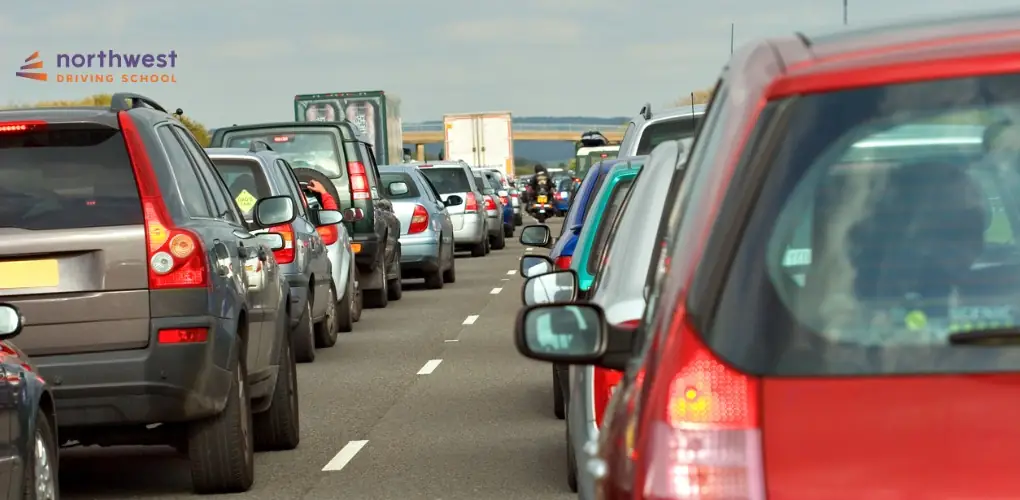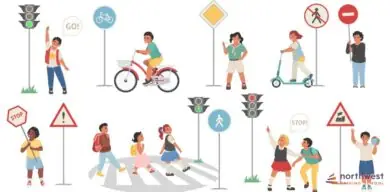- Traffic School
Do You Know The Stopping Distance Of Your Car?

Knowing how long it takes for your car to break property is important information. Braking distance is impacted by driving habits, driving speed, weather conditions, and type of vehicle.
This article will look at what factors influence braking distances and provide you with a stopping distance chart so you can be more informed on the matter!
Read More: The Basics Of Stopping Distances
Table of Contents
What Is Stopping Distance?
Calculating stopping distance is easy. You take the speed you’re driving and multiply it by how many feet you go in one second. The number you get is the total stopping distance of your car.
For example, driving a car at 60 miles per hour (mph) for 100 ft would equal to 600ft or 0.15 mi before it came to a complete halt.
However, your car stopping isn’t the only thing you must consider. There is also how long it takes you to react to the situation and hit the brakes. This is called the thinking distance.
Usually, driving at a speed of 25mph only takes you about three seconds to hit the brake. However, when driving in heavy traffic or during poor weather conditions, the thinking distance can increase drastically and add more time before your car actually comes to a halt.
So, your true stopping distance is your thinking distance plus your actual braking distance.
>>>>> Image credit – Red Driving School
Factors That Impact Braking Distance
Read More: What Factors Affect Stopping Distance?
Some of the most common factors that impact braking distance include :
Driving Speed
The faster you drive, the more force you need to stop your car. Consequently, stopping distance increases with speed and will be much longer than if you were driving at a slower pace.
Driving downhill can also impact braking since gravity makes it harder for brakes to work properly under pressure.
Weather Conditions
The weather conditions on the road significantly impact your braking distance. For instance, driving on wet roads or braking during a downpour will have an impact.
If you drive downhill in the rain and the brakes fail to work properly, your car may go over the cliff’s edge or into oncoming traffic.
Car Condition
The existing condition of your brakes and tires can significantly impact your braking distance. When driving, your car’s stopping distance is measured from when you first apply pressure to break and then release it.
A regular braking test will give you a good idea of how well your brakes work. Your best bet would be to drive with caution at all times since driving in an unsafe manner can impact yourself and those around you.
Factors That Impact Thinking Distance
Some of the most common factors that impact thinking distance include:
Tiredness
A direct correlation exists between driving while tired and the increased braking distance. The more tired you are, the slower your mind works and the longer the thinking distance is before you actually break. We’ve said it before and we’ll say it again, don’t drive tired.
Distractions
Distractions impact your attention on the road. When driving and distracted, your thinking distance can be up to four times as long.
Actions like talking to other passengers, using a mobile phone, driving while consuming alcohol, driving under the influence of drugs, and even loud music can all play a role in increasing your thinking distance.
How To Decrease Your Stopping Distance
The best way to decrease your stopping distance is by driving as if there were a rock under the accelerator pedal. Keep your speed low and keep your eyes on the road,
This means that you should be driving at all times with complete attention to what is happening around you and keeping both hands on the wheel in a ten-and-two position.
Also, avoid slamming on the brakes when driving fast. This can cause the car to go into a skid.
Instead, always apply your brakes smoothly and slowly until you have come to a complete stop.
If driving fast in snow or rain is unavoidable for any reason, keep your speed low, as driving at high speeds increases stopping distance dramatically due to the impact of momentum on water and slush particles.
Start Your Driving Journey In Nevada Now!
Learn to drive in Nevada with Northwest Driving School! We teach driving and traffic rules in Las Vegas with experienced instructors. Our cars are safe, and we check all instructors to make sure they are DMV Certified. We aim to give best lessons and practice driving safely. Most of our students, 98%, pass their driving test the first time. Call (702) 212-5667 to start learning with us.



